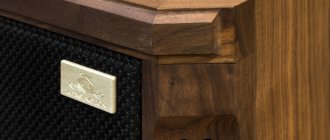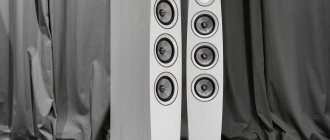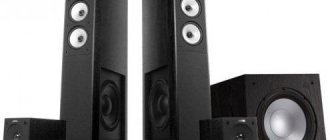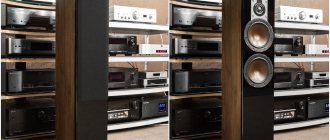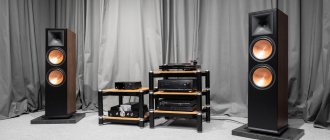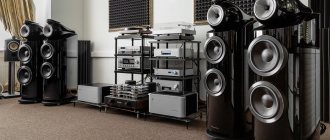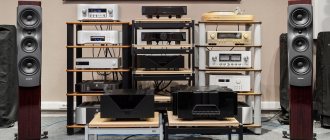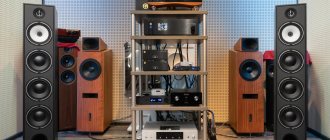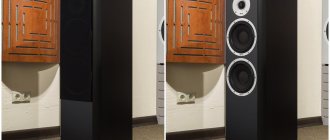“Happiness for everyone, for free!” dreamed a character in the famous book by the Strugatsky brothers. Arslab acoustics, I’m not afraid of this word, are a special (and therefore possible) case of the implementation of a utopian idea. Judge for yourself: all the hallmarks of High End, a meticulous approach to production quality and components, and most importantly, the price of a mid-budget model. All together, this occurs little more often than the free distribution of happiness in a single universe.
In order not to be accused of bias or irrational thinking, I will immediately hasten to reveal the main secret of Arslab. The whole point, of course, is not the insane generosity of the manufacturer, but a properly structured business model. In a normal situation, foreign-made acoustics are first imported into the country by a distributor, from him it goes to a local dealer in a store, where the end user can finally purchase it. Each movement of acoustics from one company to another is a sale, inevitably accompanied by an increase in the retail price. And this is understandable: which of the manufacturers and suppliers of expensive acoustics will refuse a good markup in their favor?
Both with and without a grill, the Classic 2 has an absolutely classic, traditional look.
As a result, it turns out that acoustics assembled using expensive audiophile components cost “great thousands,” and all the shortcomings of mid-budget Hi-Fi are explained by the sacred phrase: “What did you want for a thousand dollars?!”
The situation with Arslab is completely different. The brand and production belong to one of the largest retailers of Hi-Fi and High-End equipment in Russia. Since in this case the manufacturer and the seller are one person, the number of markups is sharply reduced, reducing the final price several times. It’s good for the buyer and the seller/manufacturer has the right income.
Non-standard confirmation
I won’t go into much detail about the history of the brand and production base; we talked about this earlier in the article “How Arslab reduced the number of zeros on high-end audio price tags.” I will only mention the current state of affairs: the factory is located in Latvia, and senior positions are occupied by people from the legendary Riga radio factory. The company manufactures the cases itself. The speakers in the current Classic version are from Wavecor, a Chinese brand with Danish roots. I note that the drivers are manufactured according to Arslab specifications and are fully compliant with the High-End class.
The fact that they are non-standard can be easily determined by the size of the tweeter installed in the Classic 2. It has a large 30 mm fabric dome with a wide surround molded from the same material, adding at least another centimeter to the diameter. The 146-mm midrange driver is also not simple: in its center, a bullet-shaped phase-leveling body is installed on the core - a specific element, selected “from scratch” for each specific speaker model. The lower frequencies are voiced by two drivers of similar size with large dust caps made of thick paper.
Tweeters larger than 25mm tend to sound richer and more natural
The switching circuit is a traditional three-way. The crossover is assembled in the most audiophile way possible - by hanging mounting. The components are of high quality, as befits a solid acoustic system that aspires to High End status. Capacitors: Audiocore and Mundorf, Jantzen inductors. There is one pair of terminals installed, spaced so wide that they are easy to screw. Anyone who fundamentally uses stripped cables without lugs will especially appreciate the design and quality of the terminals.
How Arslab acoustics are created and why High-End can be sold at the price of Hi-Fi
Bookshelf speakers Arslab Old School Superb 90
In today’s material, we will talk about how the work on speakers of the Arslab brand takes place, and we will tell you how you can “cut off zero” on the price tags of high-end acoustics.
But first, let's look at how the audio market works: why are there so many brands producing audio systems? It would seem that there is a basic theory for designing linear systems, one approach to creating linear sound with the least distortion - just use it, and you can easily capture the market? Not certainly in that way.
The fact is that engineers care not only about the sound “in itself,” but also about its perception by the listener, which depends on many factors: firstly, physiological and psychological - the curve of our perception of sound is nonlinear, and secondly, a lot depends on , under what conditions, at what volume a particular music lover prefers to listen to recordings.
The perception of sound changes with age, depends on the surrounding space, is distorted if a person is intoxicated (this, in part, explains the disappointment of those who worry that their favorite speakers do not sound “like at a rock concert”) - and all this affects the work of engineers.
In fact, the monolithic market of music lovers for the manufacturing company is divided into hundreds of subgroups: aging rockers with listening rooms in country houses, young fans of electronic music who often travel by subway, sports fans, classical fans living in small apartments - all of them (and many others) perceive sound differently, and they all need different products.
How to create a product for so many different people? Often an engineer will identify himself, his preferences and lifestyle with one of these groups and do what he likes in the hope that someone else will like that sound. He deliberately introduces his elements, distorts the sound, so that the system sounds especially good, say, at the volume that he (the engineer) considers optimal.
A complete dictatorship: however, this approach works - if you see equipment from a particular brand on a stand in a store, it means that it already has a circle of fans - people who listen to music in the conditions “under which” the engineer created this system.
The engineer whose developments underlie the Arslab brand is Yuri Fomin (previously developed speaker systems for the brands Jetbalance, Defender, AVE). Before starting to design acoustic systems, Yuri Fomin worked as a studio and concert sound engineer, played guitar - all this left its mark on the Arslab “sound philosophy”:
We, together with the second leading engineer, were engaged in professional sound.
We've done a lot of studio work, we understand how everything sounds live. Yes, perhaps we both have a certain taste, instilled by the studios, which we are trying to recreate. But this taste is neutral. Ideally, there are no features inherent in the system at all - Yuri Fomin
Of course, it is impossible to accurately recreate all the nuances of sound that the sound engineer intended - to do this, you must, at a minimum, be present in the studio at the time of his work, however, Arslab believes that a focus on stylistic “neutrality” can give the acoustics individuality:
We consider the approach “here metal sounds worse, but classical sounds better” to be incorrect.
The equipment should be able to play everything; let the buyers set their priorities. This is our philosophy. It is important for us that a person believes that his favorite music plays best on our systems. If he loves metal, let him say that it is intended for this genre. If it's the blues, well, let the blues play the best. […] We are still looking for [“our” sound], but we are already being told that “we recognize your sound from afar”– Yuri Fomin
The Arslab acoustics themselves have two non-trivial (for the acoustic systems market as a whole) features: Russian engineers and the (Russian) company Audiomania are behind its development, and it is produced under the slogan “High-End at the price of Hi-Fi.” Let's figure out how this was achieved.
From idea to factory
The idea to create his own brand producing acoustics came to the founder of Audiomania, Artem Firemark, after meeting Yuri Fomin and his company F-lab in 2000.
For the next eight years, the future creators of Arslab visited foreign factories, got acquainted with their owners and leading engineers, as well as how the production of equipment was organized, and created experimental samples. The production of speakers began in 2008 - they were based on the developments of F-lab, the Taiwanese company TB Speakers (initially, speakers from this brand were used in Arslab speaker systems), and the manufacturing of the cabinets took place in China.
Very soon the company realized that this was not a convenient enough format: Chinese factories prefer large orders and do not experience a shortage in supply - production is usually fully loaded, so in order to make a batch, you need to wait for your turn. And exercising control over production in Chinese factories is not only difficult, but also expensive.
This is how the idea of creating our own production facility emerged, which would produce everything from the “filling” to the cabinets (the same period saw the beginning of Artem Firemark’s collaboration with Allan Isaksen, the founder of the European speaker manufacturer Wavecor, whose products Arslab systems are still equipped with) .
They decided to locate the production in Riga - specialists who worked at the Soviet Radiotehnika plant still live there and are familiar with the production of acoustics firsthand (employees who have experience in producing acoustics in Scandinavian countries also work at the plant).
Riga was also chosen as a site for the plant because this region provides quite a lot of freedom for manufacturing business: on the one hand, it is quite close to Russia (while Arslab speakers are produced mainly for Russian music lovers), on the other hand, there are fewer problems with import and “customs clearance” of imported components.
As production increased, the plant began to produce products from other high-end brands. The most striking example of this is the acoustics of the Penaudio company, whose controlling stake Audiomania acquired not so long ago. Now Audiomania deals with everything related to the marketing and distribution of Penaudio speakers, and their creator Sami Penttilä can devote all his time to developing new models and monitoring the production process - he comes to the plant in Riga every month.
From the buildings...
The production of acoustic enclosures is carried out on a special German woodworking machine.
The machine performs operations in a three-dimensional coordinate system - with its help you can create cabinets of unique shapes. Therefore, now, in addition to Arslab acoustic systems, the plant in Riga also produces custom-made housings for other companies. They use materials from budget ones - for example, Latvian plywood (made entirely from birch), to classic oak, walnut, ash or cherry and even exotic zebrawood and expensive rosewood and Karelian birch. However, even for budget models, technologists try to select high-quality materials: for example, high-density MDF, used in the cases of most models, is imported from Germany.
To make the cabinets of Penaudio acoustics, they use a unique finish that has become the company’s “calling card” - transverse layers of plywood. The Riga plant even managed to improve the technology for their creation compared to the original Finnish approach.
After “cutting,” the workpiece goes through the stages of assembly, gluing, varnishing or painting and drying. Most of them are done strictly by hand. Then the finished case is equipped with speakers, crossovers, connector blocks and other “stuffing”. At the same time, product testing occurs at every stage of production - thanks to this, the percentage of defective products tends to zero.
The plant's chief technologist, Viktor Lagarpov, notes: finished acoustics are returned to the plant only if they were damaged in a store or showroom: the current approach allows us to avoid defects in production. There, at the plant, Yuri Fomin and a team of sound engineers also test new equipment in laboratory conditions: some copies subsequently become production Arslab models.
...before packaging
It would seem that everything, the column has gone through the entire assembly stage, but it is also important to pack it correctly - this is the only way to guarantee the safety of the goods during transportation.
To achieve this, the Audiomania plant came up with several know-hows. When packing speakers, employees use latex or vinyl gloves - they do not leave marks on the polished surface. The speakers themselves, coated with varnish, are wrapped in a special non-woven packaging material that does not leave any traces on the varnish. It is supplied to the plant from China - packaging like this is not made anywhere else.
Viktor Lagarpov emphasizes: if you pack the speakers in ordinary fabric or film, the likelihood that they will be scratched increases sharply. In addition, the non-woven material allows the speakers to “breathe”.
The boxes in which the speakers are packaged (this applies primarily to the most expensive models produced) are made from a combination of plywood and durable cardboard. Such packaging is much stronger than ordinary packaging cardboard, but at the same time more environmentally friendly than wooden boxes (similar options - packaging made of wood - are also found on the market).
The fact is that plywood, firstly, is made from industrial waste, and secondly, it does not require additional treatment with chemicals (the sanitary and epidemiological inspections of many countries often insist on the latter in the case of using wooden, rather than plywood, boxes).
After the column is wrapped in non-woven material and placed in a box, the remaining space is filled with special packaging foam, which quickly expands and fills all voids. This allows you to avoid using earbuds in the packaging (which need to be changed depending on the model of acoustics and the size of the packaging) and further increases its reliability.
Typically, a stapler is used to secure wooden-plywood boxes, but in this case, after unpacking, the wood or plywood turns into waste. Audiomania has come up with a way to reuse durable packaging material many times: to do this, a separate employee in production fixes the boxes with self-tapping screws. The combination of all these factors provides an almost 100% guarantee of reliable transportation of goods – even if the boxes are stored in large stacks.
High-End at the price of Hi-Fi
The peculiarities of the production and development of audio equipment largely explain the bold motto of Arslab, and why Audiomania managed to seriously reduce the price tag for “its” speakers.
For example, the decision to manufacture cases on its own equipment allowed Audiomania to exclude additional links from the production process, which otherwise would have led to an increase in the cost of the product: and this includes payment for the work of a third-party manufacturer, and logistics costs, and losses due to the need to wait for one’s turn, as is the case with Chinese case suppliers.
In the same way, the reduction in the final price is also affected by the fact that Audiomania itself develops and sells acoustics of its own brand: the company does not need to overpay for third-party R&D, and wholesalers and distributors “leave” the chain connecting the manufacturer and the buyer.
As for the components that still have to be purchased from third-party manufacturers, Audiomania tries to establish the most comfortable and efficient working conditions with them - and use this so as not to increase the price tag once again.
For example, Audiomania's close collaboration with speaker manufacturer Wavecor allows the company to purchase components in bulk and use them as needed. At the same time, Wavecor respects the requests of the Russian side to change certain parameters of its products in accordance with the engineers’ ideas.
Does all this speak in favor of Arslab speakers? Only the listener can determine:
You can only understand whether you like it or not by turning it on and listening.
Each system is a product of the creative state of the development engineer. He puts his soul into his work - Yuri Fomin
PS More materials on the topic of audio technology can be found in our blog “World of Hi-Fi”.
Double bottom
The body is a source of special pride. It is produced entirely in-house by Arslab with a minimal degree of automation. The only automated process is MDF cutting, which is performed on a CNC machine. Next, the cut and milled sheet is assembled by hand, glued together, and partitions are inserted inside. All surfaces from the inside are damped with a layer of bitumen and then damped with special Danish-made acoustic foam. If, out of curiosity, you look inside the body of some other acoustics of a comparable price, in 90% of cases you will see bare MDF and, at best, a lush piece of padding polyester as a sound absorber.
The vast majority of assembly and finishing operations are done by hand, including painting, applying and polishing multiple layers of varnish. Each pair of speaker systems is a unique product with its own serial number. Everything is in the best High End traditions.
The proportions and dimensions of the Arslab Classic 2 case are quite classic by modern standards: an absolute rectangle with sharp edges, a narrow 180 mm facade and a height of about one meter. The weight is quite substantial, the weight of one speaker is 20 kg. Thick walls and a large number of internal partitions with holes that act as stiffeners have an effect.
The acoustics have a double bottom. A platform of the same size as the bottom is screwed to the main body from below, and four height-adjustable spikes are screwed into it. They fit perfectly into carpet, but if you have laminate or parquet on the floor, which is especially dear to you, I recommend that you immediately buy beautiful anti-vibration stands for spikes or use coins the old fashioned way.
Adjustable spikes and MDF base provide good vibration isolation
The acoustic design of the case is bass reflex. One large diameter port is located on the rear wall. As a result, the bass is clear, without pronounced prolongation or mixing of notes. The boominess characteristic of this arrangement is minimal and noticeable only on the lower notes. Actually, it's time to move from physics to lyrics.
